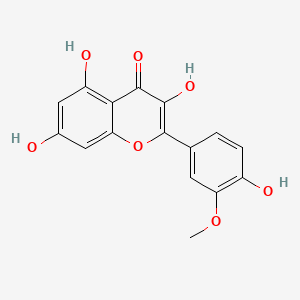Isorhamnetin
Isorhamnetin is a lipid of Polyketides (PK) class. Isorhamnetin is associated with abnormalities such as Facial Hemiatrophy, Colitis, endothelial dysfunction, Morphologically altered structure and Diabetes. The involved functions are known as enzyme activity, Methylation, Anabolism, Binding (Molecular Function) and Vmax. Isorhamnetin often locates in Body tissue, Cytoplasmic, Mucous Membrane, Cytoplasm and Human tissue. The associated genes with Isorhamnetin are CSK gene, RPS6KA3 gene, Mitogen-activated protein, NCF1 gene and Chromatin. The related lipids are Fatty Acids, Phosphatidylserines and Palmitates. The related experimental models are Mouse Model, Xenograft Model and Streptozotocin Diabetes.
References related to locations published in J. Nutr.
| PMID | Journal | Published Date | Author | Title |
|---|---|---|---|---|
| 20739450 | J. Nutr. | 2010 | Garrido I et al. | Targeted analysis of conjugated and microbial-derived phenolic metabolites in human urine after consumption of an almond skin phenolic extract. |
| 17374653 | J. Nutr. | 2007 | Sanchez M et al. | Quercetin and isorhamnetin prevent endothelial dysfunction, superoxide production, and overexpression of p47phox induced by angiotensin II in rat aorta. |
| 15930439 | J. Nutr. | 2005 | Chen CY et al. | Flavonoids from almond skins are bioavailable and act synergistically with vitamins C and E to enhance hamster and human LDL resistance to oxidation. |
| 18641184 | J. Nutr. | 2008 | Bieger J et al. | Tissue distribution of quercetin in pigs after long-term dietary supplementation. |
